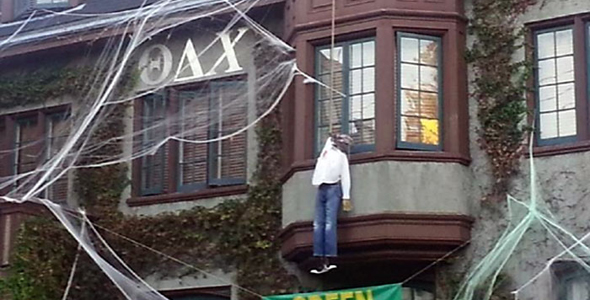Real Life Halloween Horror – True Halloween Stories
If you thought the only things killing people on Halloween night were needle filled apples and chocolates, think again. In fact, nobody has ever been killed by such a thing in the history of man or Halloween. While most cases of needles in the candy have been proven complete hoax, the phenomena has occured before but only resulted in minor injury. But what fun is that? Let’s take a look at some true Halloween horror stories where the victims weren’t so lucky!
Bodies of suicide victims have been mistaken for Halloween decorations

State police spokesman Cpl. Jeff Oldham and neighbors said people noticed the body around 7:30 that morning but dismissed it as a holiday prank. Authorities arrived at the scene at 11:00 to begin the process of examining the scene and removing the body. The deceased lived about a quarter-mile from where her body was discovered.
Similarly, in mid-October 2009 the decomposing body of a 75-year-old suicide victim sat undisturbed on the balcony of the deceased’s home in Marina del Rey, California, for several days because neighbors assumed it was merely part of a Halloween display: Mostafa Mahmoud Zayed had apparently been dead [for three days] with a single gunshot wound to one eye. He was slumped over a chair on the third-floor balcony of his apartment on Bora Bora Way, said cameraman Austin Raishbrook, who was on the scene when authorities were alerted to the body.
Neighbors told Raishbrook that they noticed the body [three days earlier] “but didn’t bother calling authorities because it looked like a Halloween dummy,” he said.
“The body was in plain view of the entire apartment complex [and] they all didn’t do anything,” Raishbrook said. “It’s very strange. It did look unreal, to be honest.”
An investigator with the Los Angeles County Sheriff’s Department said the case is an “apparent suicide,” and declined to comment further. These grisly accounts of suicides being mistaken for Halloween tomfoolery is the reverse of what we’ve previously seen: deliberate attempts at presenting spooktacular visual effects resulting in actual, accidental demises. All too often, young persons called upon to stage fake hanging scenes as part of scary tableaux have fatally miscalculated, thereby ending their lives.
The Disappearance Of Hyun Jong ‘Cindy’ Song

Shortly thereafter, a witness reported seeing a woman resembling Cindy in the Chinatown district of Philadelphia. This woman was inside a vehicle with an unidentified male and crying out for help. A bizarre lead came about in 2003 when a Luzerne County man named Hugo Marcus Selenski was arrested after the remains of five people were found buried in his backyard.
Even though none of these remains belonged to Cindy, an informant told police that Selenski and an accomplice named Michael Jason Kerkowski Jr. had abducted her. After Cindy was raped and murdered, the two men allegedly buried her body at another location. Kerkowski’s remains were found in Selenski’s backyard, and the informant claimed Kerkowski was murdered for keeping Cindy’s bunny ears as a souvenir. Thus far, no evidence was found to tie Selenski to Cindy’s disappearance, but in January 2014, the burned remains of a dozen more people were found buried on his property. It remains to be seen if any of them will be identified as Cindy Song.
Halloween Poisonings

It’s a sadness that a holiday so thoroughly and greedily enjoyed by kids is being sanitized out of existence in the name of safety. Sadder still is there appears to be little reason for it.
Though I’ve yet to find evidence of a genuine Halloween poisoning, I have uncovered a few isolated incidents initially reported as random poisonings that, upon further investigation, turned out to be something else.
Let’s set the criteria for what constitutes a Halloween poisoning and then examine the famous and not-so-famous cases often pointed to as examples of this horror: To qualify as a Halloween poisoning, poisoned candy has to be handed out on a random basis to children as part of the trick-or-treating ritual inherent to Halloween. The act cannot be targeted to any one specific child. By far the most famous case of Halloween candy poisoning was the murder of eight-year-old Timothy Marc O’Bryan at the hands of his father, Ronald Clark O’Bryan, in Houston, Texas. The child died at 10 p.m. on 31 October 1974, as a result of eating cyanide-laced Pixie Stix acquired while trick-or-treating.
To make his act appear more like the work of a random madman, O’Bryan also gave poisoned Pixie Stix to his daughter and three other children. By a kind stroke of fate, none of the other children ate the candy.
The prosecution proved the father had purchased cyanide and had (along with a neighbor) accompanied the group of children on their door-to-door mission. None of the places visited that night were giving out Pixie Stix. Young Mark’s life was insured for a large sum of money, and collecting on this policy has always been pointed to as the motive behind this murder.
Though the case was circumstantial (no one saw the father poison the candy or slip the Pixie Stix into the boy’s bag), Ronald O’Bryan was convicted of the murder in May 1975. He received the death sentence and was executed by lethal injection on 31 March 1984 (not on the poetically-just 31 October as is often recounted in off-the-cuff retellings of the case).
he O’Bryan murder was an attempt to use a well-known urban legend to cover up the premeditated murder of one particular child. (Note that for this explanation of the boy’s murder to have been believed, the legend had to have been in wide circulation by 1974.) Though cold-blooded and horrible to contemplate, this crime still does not qualify as a genuine Halloween poisoning because there was nothing random about Timothy O’Bryan’s death. (The specter of the mad poisoner from the 1982 Tylenol murders was similarly employed by various murderers attempting to cover their tracks.)
The Identity Of ‘Orange Socks’

Years later, serial killer Henry Lee Lucas confessed to the murder of “Orange Socks.” He even stated that he had sex with her corpse after she was dead. However, Lucas did not know the woman’s identity. He claimed he picked her up while hitchhiking and only remembered that her name was “Joanie” or “Judy.” After being sentenced to death for the woman’s murder in 1984, Lucas recanted his confession in order to have his sentence commuted. Indeed, further investigation showed that Lucas was likely working in Florida on the day of the murder. Lucas was notorious for frequently confessing to murders he never committed, and no one is sure how many people he actually killed. Henry Lee Lucas died in prison in 2001, but “Orange Socks” is not the only unidentified murder victim that he has been connected to.
A chainsaw-wielding ‘madman’ turns out to be a partygoer who’d gone to the wrong house.

Fearing he was about to be taken apart limb by limb the desperate “victim” dashed to the phone to alert officers of the impending bloodbath. But police who raced to the address in Atwater Close, Lincoln, last night arrived to find the chainsaw-wielding offender gone. It later transpired that the menacing character waving the 3ft-long power tool had in fact got the wrong address for a fancy dress party.
Police said he had been intent on making a dramatic entrance to the soiree and was dressed as hell-raising rap star Eminem. Upon realising his mistake he skulked off into the night, chainsaw in tow. A Lincolnshire Police spokesman said: “The poor occupant was clearly frightened out of his skin. “The guy turned up at the door with the chainsaw running and must have looked terrifying.
“Luckily he had simply gone to the wrong door. It must have been rather embarrassing for him.”
Ever since 1992, when 16-year-old Japanese exchange student Yoshihiro Hattori was mistakenly killed in Louisiana after he knocked on the wrong door in search of a Halloween party (and the resident, mistaking him for an intruder, shot him to death), tales about party-goers dressed as characters from horror films being mistaken for real killers have seemed a little less funny.
Nonetheless, such stories continue to pop up in the news every once in a while. The example quoted above — about a chainsaw-wielding man dressed in ski goggles and salopettes who accidentally turned up on the wrong doorstep and had the police called on him by the frightened resident — was reported by the British press in late October 2002 (but contained too little in the way of checkable details to make it easily verifiable).
(Salopettes, by the way, are high-waisted weatherproof pants upheld by built-in suspenders. Skiers, motorcyclists, snowmobilers, and others engaged in chilly outdoor sports, routinely don them for protection and warmth. To have a look at some different styles of them. In April 2008, the British press again reported an incident involving a masked, chainsaw-wielding party-goer whose presence startled area residents into sending the police after him:
A man walking the streets of a town with a running chainsaw and a mask sparked a major armed police operation. Concerned residents dialled 999 after spotting the man walking along Churchill Road, Bicester, Oxfordshire. Armed police arrived but found that the man, whose chainsaw had no blade, was going to a fancy dress party as horror film character Jason.
He was warned that he had to turn the saw off but allowed to continue to the party.A Thames Valley Police spokesman said: “He was warned about his actions and told he faced arrest or a fixed penalty notice if he did not turn the saw off.”It looks like he was in fancy dress but it was not a funny incident for worried residents.”
Pins, needles, and razor blades have been found in trick-or-treaters’ loot

To my mind, these cases constitute a different class of tampering than poisoning for a couple of reasons. First, the expected level of harm is severely reduced: poison is an attempt to kill; a pin in an apple is an attempt to frighten or injure. Professor Joel Best reported that he’s been able to track about eighty cases of sharp objects in food incidents since 1959, and almost all were hoaxes. Only about ten culminated in even minor injury, and in the worst case, a woman required a few stitches. Compared to “eat something and die,” a couple of stitches barely registers on the scale.
Second, the motivation for “pins and needles” tampering is different. As I said before, poison is an attempt to kill, but hiding a needle in an apple is almost always a prank, not a serious attempt to cause harm. (In those instances where such an insertion could be traced back to a specific person, it was almost always some kid intent on freaking out either his little brother or his parents or getting the community in an uproar as his version of a cute Halloween “trick”). Pranking (especially when it’s a scary or slightly mean one) is part of Halloween, and the various kids or young adults who’ve tampered with treats most likely never fully considered the potential consequences of the joke prior to embarking on it. (When presented with a matchless opportunity to throw a scare into a pesky kid brother, who stops to think that Junior might get hurt?)
An incident that broke with this expected pattern occurred in Minneapolis in 2000, when 49-year-old James Joseph Smith was charged with one count of adulterating a substance with intent to cause death, harm or illness after it was determined he’d put needles in Snickers bars and handed them out to children on Halloween. A 14-year-old boy was pricked by a needle hidden in a bar he’d bitten into, but no one required medical attention.
As author Jack Santino noted in his history of Halloween, “pins and needles” rumors began to supplant “poisoned candy” rumors in the mid-1960s, and nearly all such reports of such rumors proved to be hoaxes:



